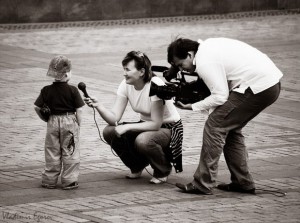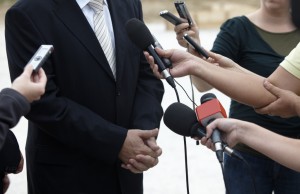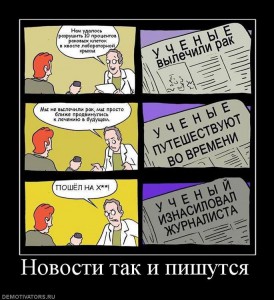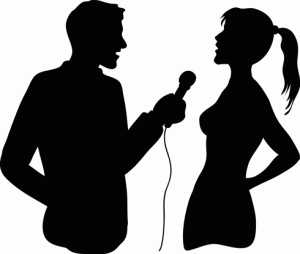Интервью как жанр журналистики, а теперь и контент-маркетинга
 Интервью – это литературное изложение беседы журналиста с человеком, мысли, комментарии или пояснения которого по определенным актуальным вопросам жизни вызывают общественный интерес. Это совместное творчество журналиста и человека, дающего информацию.
Интервью – это литературное изложение беседы журналиста с человеком, мысли, комментарии или пояснения которого по определенным актуальным вопросам жизни вызывают общественный интерес. Это совместное творчество журналиста и человека, дающего информацию.
Существуют интервью-диалог – разговор с одним человеком по схеме «вопрос-ответ» и интервью-монолог – журналист ставит вопрос, задает тему, а собеседник рассказывает. Задача журналиста здесь передать рассказ максимально точно, с сохранением особенностей речи того, кто дает интервью.
Качество и характер вопросов интервью зависит от темы беседы. Некоторые из вопросов возникают в ходе беседы, но основные следует подготовить заранее, с учетом того, что именно интересует общество. Искусство журналиста направлять беседу в русло проблемы, интересующей его.
Вопросы должны быть:
- короткими, лаконичными,
- четкими,
- “открытыми”, т.е. формулироваться так, чтобы собеседник не имел возможности ответить «да» или «нет».
Ответы должны быть:
- развернутыми,
- обоснованными.
Интервью могут быть как индивидуальными, так и коллективными, когда сразу несколько человек выражают свое мнение по поводу затронутых вопросов.
В ходе беседы журналист уточняет отдельные моменты, задает вопросы, следит за тем, чтобы разговор шел в нужном направлении. Просит подробнее высказаться по поводу вопросов, представляющих наибольший интерес. Т.е. журналист стремится, чтоб беседа была содержательной и интересной для обоих.
Если человеку нечего сказать, начинать разговор не стоит. И если журналист не подготовлен, не знает о чем будет идти речь, не умеет формулировать вопросы так, чтобы заинтересовать собеседника, не умеет быть непринужденным, откровенным, то интервью не получится содержательным и интересным.
Интервью печатается в СМИ с разными целями:
- сообщить читателям о чьих-то планах, задачах,
- рассказать о творческих успехах, достижениях,
- разместить информацию о предстоящем событии, к которому заранее готовятся, или сообщить подробности уже прошедшего,
- разъяснить более подробно тот или иной факт уже известный читателю,
- узнать мнение политического, творческого, гос. деятеля по какому-либо вопросу.
Очень важно для журналиста точно изложить запись интервью, чтобы избежать перекручиваний, ошибок, неточностей. Можно согласовать материал с собеседником после его обработки. Переносите интервью на бумагу не откладывая, пока его подробности хранятся в памяти.
В чем заключается искусство интервью?
Начальная стадия беседы
Вступление должно быть кратким (без лишней настойчивости) журналист должен
- представиться,
- сообщить от имени какого СМИ он выступает,
- почему решил обратиться именно к этому человеку,
- изложить цели беседы,
все это нужно продумать заранее и построить свою речь так, чтобы вызвать у собеседника интерес к сказанному, желание сотрудничать. Нужно обратить внимание на формулировку вопросов. Они должны быть понятны собеседнику. Хорошо, если первые вопросы покажут компетентность журналиста, его подготовленность к интервью. Когда собеседник чувствует, что журналист знает дело, готовился к разговору, у интервьюируемого появляется более серьезное отношение к журналисту. Собеседник охотнее делится своими мыслями, проблемами.
ВАЖНО: Первые вопросы должны быть интересными, втягивать собеседника в разговор.
Темп беседы
 Темп беседы зависит от характера обсуждаемых вопросов, свойств личности собеседника, времени, которым располагают его участники и т.д. Ни в коем случае нельзя торопить собеседника, т.к. это может вызвать не желаемую реакцию: раздражение, смущение, стремление поскорее закончить разговор. Если интервьюируемый отклонился от темы, а журналист не располагает временем, можно корректно, тактично, с помощью дополнительных вопросов направить беседу в нужное русло. Особую чуткость и деликатность нужно проявлять в личностном интервью, где неосторожным словом, невпопад сделанным замечанием можно разрушить контакт.
Темп беседы зависит от характера обсуждаемых вопросов, свойств личности собеседника, времени, которым располагают его участники и т.д. Ни в коем случае нельзя торопить собеседника, т.к. это может вызвать не желаемую реакцию: раздражение, смущение, стремление поскорее закончить разговор. Если интервьюируемый отклонился от темы, а журналист не располагает временем, можно корректно, тактично, с помощью дополнительных вопросов направить беседу в нужное русло. Особую чуткость и деликатность нужно проявлять в личностном интервью, где неосторожным словом, невпопад сделанным замечанием можно разрушить контакт.
В чем заключается искусство беседы?
- Истинный журналист должен идти к собеседнику, во-первых, с мыслью, а, во-вторых, – за мыслью.
- Чтобы беседа была плодотворной, собеседник как минимум должен быть в ней заинтересован.
- Сам журналист как личность должен быть интересен собеседнику.
Советы по искусству интервью
- Не задавайте злых, провокационных вопросов.
- Давайте собеседнику возможность высказаться, не перебивайте его.
- Используйте молчание в свою пользу.
- Повторяйте свой вопрос. Если на Ваш вопрос не дан ответ, повторите его в несколько измененном виде.
Заповеди интервьюера
- Ясность и краткость. Вопрос должен быть сформулирован на языке собеседника, понятен ему, должен иметь краткую форму.
- Нельзя задавать несколько вопросов одновременно.
- Не допускайте односложных ответов.
- Конкретность ответа обуславливается конкретностью вопроса.
- Прежде чем спросить – подумайте, а интересен ли Ваш вопрос.
Проверка сведений полученных в ходе интервью
 Интервью имеет двойную субъективность: источника информации и воспринимающего информацию журналиста. Собеседник может излагать события с его точки зрения правдиво, а может сознательно давать неверную информацию. Нельзя целиком полагаться на его сведения, т.к. человеческая память имеет свойство сохранять одну информацию и утрачивать другую. Не даром журналисты говорят: «Врет, как очевидец».
Интервью имеет двойную субъективность: источника информации и воспринимающего информацию журналиста. Собеседник может излагать события с его точки зрения правдиво, а может сознательно давать неверную информацию. Нельзя целиком полагаться на его сведения, т.к. человеческая память имеет свойство сохранять одну информацию и утрачивать другую. Не даром журналисты говорят: «Врет, как очевидец».
Сведения, полученные в ходе интервью, зависят от индивидуальных свойств памяти собеседника, состояния его здоровья вообще и в момент события, от его компетентности, от ситуации беседы, его отношения к корреспонденту, от умения журналиста разговаривать и т.д.
Контроль сведений в процессе интервью может быть:
- внешним – строится на сопоставлении фактов, сообщаемых собеседником с данными, добытыми из других источников,
- внутренним – основанным на сопоставлении высказываний собеседника с его же словами.
Приемы контроля достоверности информации
- Фильтрующие вопросы. С их помощью можно определить относится ли выбранный для беседы человек к тем, которые могут ответить на вопросы данного интервью: степень его осведомленности в проблеме, является ли он очевидцем и т.д.
- Уточняющие вопросы. Детализируют сообщения собеседника, дают дополнительные сведения.
- Повторение слов собеседника. Ответ, который вызывает сомнения или не совсем понятен, можно повторить своими словами, чтобы уточнить что имел в виду собеседник.
- Вопросы-«ловушки». Чтоблы проверить искренность собеседника, можно задать ему вопрос о том, чего он заведомо не знает или о том, чего не существует в природе. Утвердительный ответ на такой вопрос заставляет усомниться в искренности других ответов.
- Проверка фактического материала. Факты, имена, названия, даты, цифры следует проверять в ходе беседы. Уточнить, верно ли они записаны журналистом и пероепроверить по окончанию беседы еще раз.
5 типов интервью
 1. Ток-шоу – теле- или радиоинтервью, общее или индивидуальное с обязательным участием зрителей в студии или посредством телефонных звонков. Ток-шоу могут быть общественно-политическими, познавательными, развлекательными.
1. Ток-шоу – теле- или радиоинтервью, общее или индивидуальное с обязательным участием зрителей в студии или посредством телефонных звонков. Ток-шоу могут быть общественно-политическими, познавательными, развлекательными.
2. Пресс-конференция. Коллективное интервью, в котором участвуют одновременно журналисты многих СМИ, которые задают вопросы на разные темы одному или нескольким известным людям (политикам, спортсменам, шоу-менам). Как правило, пресс-конференции организовываются по инициативе отвечающей стороны, которая заинтересована в том, чтобы о ней побольше узнала общественность. Каждый журналист готовит на пресс-конференцию интересные вопросы, представляя свое СМИ, но он может в подготовке материала использовать ответы на вопросы других журналистов. Т.е. пресс-конференция – коллективный труд разных СМИ.
3. Брифинг – разновидность пресс-конференции. Как правило, на них журналисты не задают вопросы, а получают информацию по какой-либо важной проблеме от лица или лиц, создавших брифинг. Он проводится с целью быстро оповестить максимальное количество СМИ, чтоб те в свою очередь донесли информацию до общественности.
4. Круглый стол – коллективное интервью, в котором журналист выступает как организатор («дирижер»). Он приглашает в студию или редакцию людей, которые могут осветить какую-либо проблему с разных сторон, имеют разные точки зрения на один и тот же вопрос. Журналист поочередно дает им слово, следит за корректностью высказываний, задает наводящие вопросы.
5. Блиц-опрос – коллективное интервью, предусматривающее опрос людей разных возрастов, профессий на улице или по телефону. Как правило, вопросы составляются короткие, вопросник состоит не более чем из 3 вопросов, которые формулируются одинаково для всех отвечающих. Проводится с целью выяснения точки зрения разных слоев населения по актуальным вопросам жизни общества.
Эксперт в области интернет-маркетинга. Руководитель маркетингового агентства MAVR.
Бизнес-степень «Мастер делового администрирования» (MBA).

